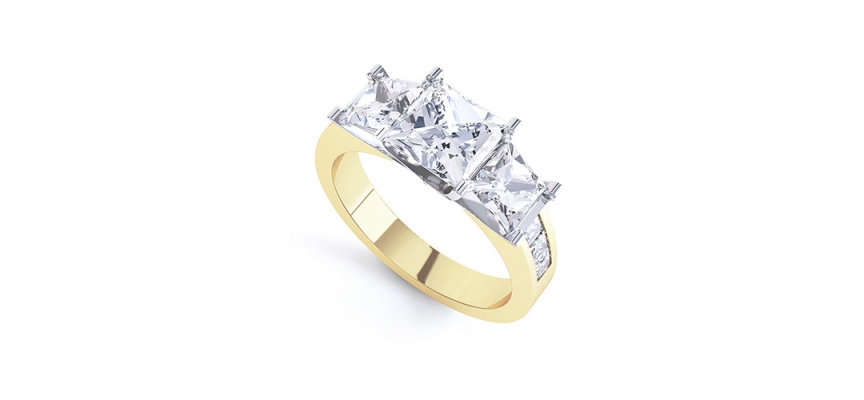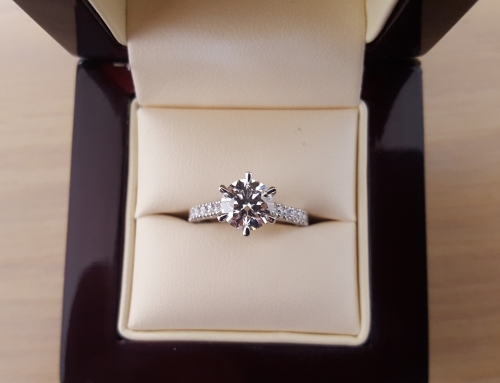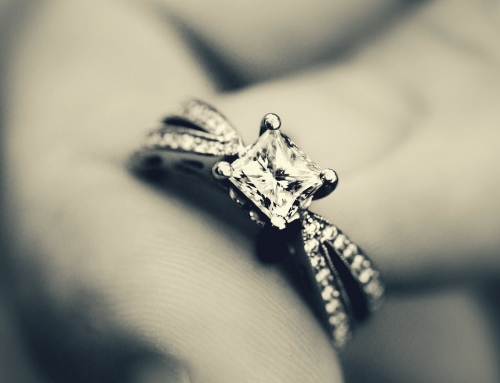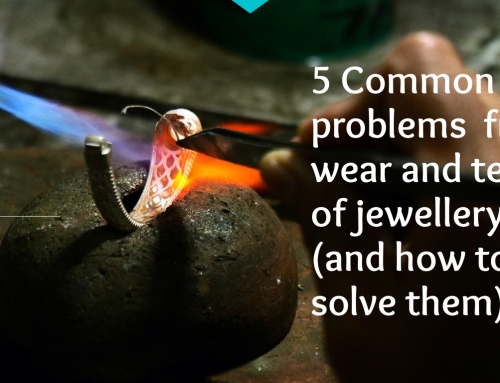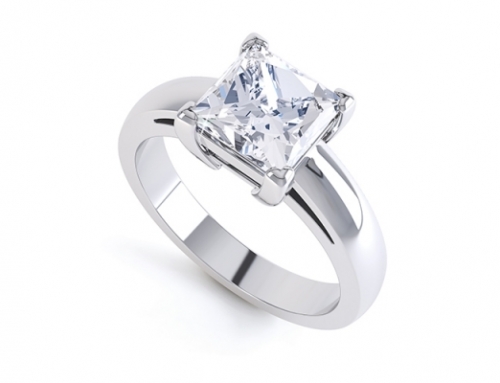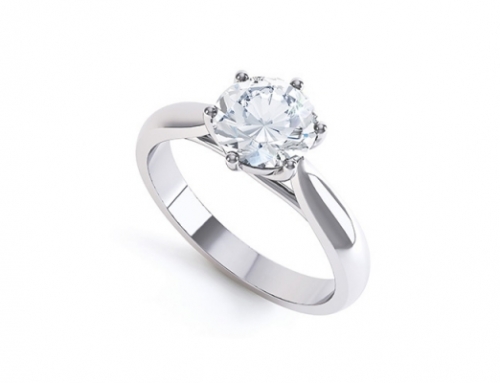Shape & characteristics
The Princess cut is an amazing shape of diamond. It has amazing sparkle and offers excellent value for money. The Princess cut is a square shape whose facets reflect the brilliance of a Round Brilliant cut and hence, are ideal for those who like the brilliance of a round but prefer a square shape. It was first introduced in the 1960s. Its precursor was the ‘Barion cut’ invented by Basil Watermeyer. However, the Barion cut was like a radiant cut with clipped corners.
The actual shape of a Princess cut diamond mimic the shape of an octahedron, a common shape of a rough diamond crystal. Therefore, it can offer excellent yield to cutters resulting in lower cost per carat for the manufacturer and lower prices (relative to the Round Brilliant cut) for the consumer.
Unfortunately, many manufacturers cut the crystal to maximise yield, at the expense of beauty and light reflection (‘sparkle’). The most popular diamond grading organisation – the Gemmological Institute of America (GIA) do not grade cut quality of Princess cuts (or for any other fancy shape diamonds), so it becomes difficult for a consumer to appreciate this fact. The American Gem Society Laboratory (AGSL) are the only one who grade light performance based on the cut quality of Princess cuts.
Cutting the crystal to maximise yield at the expense of beauty is beautifully demonstrated in Image 1 which shows how an octahedron crystal is sawn into two Princess cut diamonds, one that is larger than the other. You can notice how in (1A) the cutter has maximised yield (minimise wastage) whereas (1B) shows how, if the same crystal were cut for beauty, it would create greater wastage of the rough crystal.
 Assume that the rough crystal weighs 3-carat. The traditional way of cutting this 3-carat octahedron would be through the centre and hence, yielding two approximately 1-carat Princess cut diamonds. These diamonds would maximise yield, minimise wastage of the rough crystal and being the heavy 1-carat diamonds, will get a greater price for the cutter (diamonds are cut for weight).
Assume that the rough crystal weighs 3-carat. The traditional way of cutting this 3-carat octahedron would be through the centre and hence, yielding two approximately 1-carat Princess cut diamonds. These diamonds would maximise yield, minimise wastage of the rough crystal and being the heavy 1-carat diamonds, will get a greater price for the cutter (diamonds are cut for weight).
Whereas, if the octahedron was cut just above the centre that would create one diamond that weighs a bit more than 1 carat and the second diamond would weigh approximately 0.25ct or thereabouts – a much smaller 2nd stone. These would be cut as per AGS-0-princess cut grade guidelines of the AGSL; and hence, be maximised for light return and sparkle. There will be greater wastage of the rough crystal and fetch a proportionally lesser price for the two stones as opposed to the case of the two 1-carat diamonds.
Another important characteristic of a Princess cut diamond is the fact that they can be prone to chip due to their pointed corners. The pointed corners are their weakest points. Therefore, when setting into a piece of jewellery, the jeweller will protect the corners with prongs or V-shape claws. Some diamond cutters will put a tiny facet on the corners called ‘chamfers’ to provide greater protection. This is illustrated in Image 2.
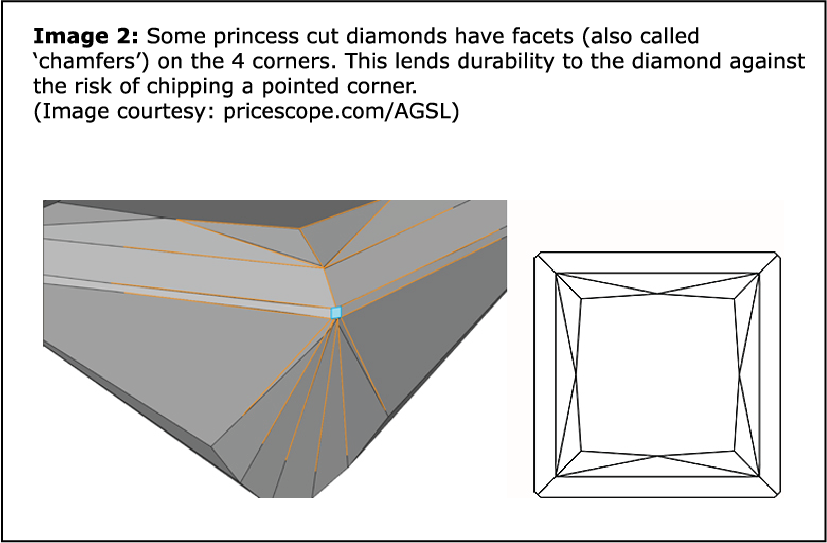
Size versus light return
Generally, a princess cut diamond can appear to look smaller than a Round diamond of the same weight from the face up position. This is because the Princess cut diamond would be relatively deeper for ideal light performance. A 1 carat Princess cut diamond would measure approximately 5.5mm from side to side (it is not measured from point to point) versus a 1 carat Round Brilliant diamond which would have a diameter of 6.5mm. Hence, the difference in face up ‘footprint’ of the Princess cut versus a Round Brilliant is 10%. This means that you can get a larger Princess cut diamond for the same money than a Round Brilliant cut!
Settings for Princess cuts
The Princess cut diamond offers enormous flexibility in terms of ring settings. They are suitable not just as an engagement ring, but also as an every-day wear ring and a right-hand dress ring. They can be designed to be set in a beautiful understated manner (like a bezel or half bezel) or in a high claw setting that would show of the bling. Remember that the sparkle of a diamond does not get adversely effected if it were set into a bezel or half-bezel as opposed to a claw set. This is because light is reflected and refracted primarily from the top of the diamond in its face up position. Every diamond has some level of light ‘leakage’ from the sides or bottom but if the stone is well cut, then it will sparkle regardless of the setting. And if it is cut simply to maximise weight then no matter how it is set, the stone will look dull and lifeless.
For those who love clean straight lines, the modern Princess cut diamond offers a beautiful option for the consumer. The fact that you can get a bigger stone for the same money compared to a Round Brilliant is an additional bonus.
Owing to the pointed corners, one does need to be mindful of the wear and tear that your jewellery is subjected to. Basically, if you show a greater degree of caution, say by not wearing your Princess cut diamond ring when your hands are subject to hard work (for example: doing dishes or house work) there is no reason why you would not enjoy your piece of jewellery for a long time to come.
You would want to consult a jeweller who is well experienced in sifting out and sourcing a stone that maximises sparkle, and then is beautifully set into a hand-made piece of jewellery that protects the stone and enhances its beauty.

